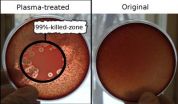Insight offers new angle of attack on variety of brain tumors
2010-12-16
(Press-News.org) A newly published insight into the biology of many kinds of less-aggressive but still lethal brain tumors, or gliomas, opens up a wide array of possibilities for new therapies, according to scientists at Brown University and the University of California, San Francisco (UCSF). In paper published online Dec. 15 in the Journal of the National Cancer Institute, they describe how a genetic mutation leads to an abnormal metabolic process in the tumors that could be targeted by drug makers.
"What this tells you is that there are some forms of tumors with a fundamentally altered process," said Karl Kelsey, a professor of pathology and laboratory medicine and community health in the Warren Alpert Medical School of Brown and one of the paper's senior authors. "This is a really new way to look at potentially modifiable factors in brain tumors."
Scientists have known for a couple of years that a mutation in a gene called IDH is associated with glioma. They've also observed that people with gliomas carrying the mutation survive longer than those afflicted with tumors lacking the mutation. What the Brown and UCSF team show in the new paper is that the mutation is associated with a consistent pattern of an alteration known as "methylation" of the DNA which is associated with changes in gene expression. The pattern of methylation in tumors with the IDH mutation often occurred in metabolic genes, regardless of the tumor's specific type.
Margaret Wrensch, a professor of neurological surgery, epidemiology and biostatistics at UCSF's Helen Diller Family Comprehensive Cancer Center, said what the team found surprising is that DNA from almost all tumors with IDH mutations had the same distinctive methylation pattern. The degree of methylation throughout the genome was unusually high, and the same specific DNA was methylated.
"This one mutation is common to a whole subset of brain tumors," she said. "It's quite unique. It seems to dominate other mutations in the tumor and the epigenetic changes are very uniform."
The researchers hope now that if a drug could inhibit this methylation process in any number of these affected genes, not necessarily just IDH, that might correct the errant metabolism of the tumors and control their growth.
"We know now that there are all these genes related to metabolism that have altered methylation," said Brock Christensen, a Brown postdoctoral scholar in pathology and laboratory medicine and a lead author of the paper, which also involved researchers from the University of Minnesota and Dartmouth Medical School. "In this suite of genes there might be a much easier target to try to design a therapy for."
The heart of the study was a tumor-by-tumor analysis of the methlylation, led by Christensen and Brown graduate student Ashley Smith, in scores of samples from the Brain Tumor Research Center at UCSF. Their analysis revealed an unusually iron clad correlation between the IDH mutation and methylation in metabolic genes in gliomas of many different names and classifications.
"The strength of the correlation was absolutely stunning," Christensen said. "It's not the kind of thing you see very often in cancer epidemiology, to have almost all of these mutant tumors having the same methylation profile."
The IDH gene has a role in glucose sensing, so the association of the mutation with altered metabolism genes (occurring through enhanced DNA methylation) is reasonable, Christensen said. The researchers are now looking into the role that mutation in IDH plays in perhaps altering other metabolism genes in the cells.
The research leaves many questions about brain tumors unanswered. Among them is what causes the IDH mutation, what causes the mutation to affect other genes in the cell, and most importantly, what is the best way take therapeutic advantage of these new observations.
But Kelsey said the fight against brain cancer has long had a dearth of hope, so he's encouraged to see some emerge.
"Gliomas are such a deadly disease, and so little is known about them, that people are pretty excited about this because it is a whole new way in," he said. "We have a new clue about what to study."
INFORMATION:
Along with Kelsey and Wrensch, a third joint lead investigator was John K. Wiencke in the department of Neurological Surgery at UCSF. Other authors were Carmen Marsit, E. Andres Houseman and Devin C. Koestler of Brown; Shichun Zheng and Joseph Wiemels of UCSF; Heather H. Nelson of Minnesota; and Margaret R. Karagas of Dartmouth.
Funding for the research came from several grants from the National Institutes of Health.
ELSE PRESS RELEASES FROM THIS DATE:
2010-12-16
Richmond, Va. (Dec. 15, 2010) – Researchers at Virginia Commonwealth University Massey Cancer Center and the VCU Institute of Molecular Medicine (VIMM) have developed a novel virus-based gene therapy for renal cell carcinoma that has been shown to kill cancer cells not only at the primary tumor site but also in distant tumors not directly infected by the virus. Renal cell carcinoma is the most common form of kidney cancer in adults and currently there is no effective treatment for the disease once it has spread outside of the kidney.
The study, published in the journal ...
2010-12-16
Absence makes your heart grow fonder, but close-quarters may boost your career.
According to new research by scientists at Harvard Medical School, the physical proximity of researchers, especially between the first and last author on published papers, strongly correlates with the impact of their work.
"Despite all of the profound advances in information technology, such as video conferencing, we found that physical proximity still matters for research productivity and impact," says Isaac Kohane, the Lawrence J. Henderson Professor of Pediatrics at Children's Hospital ...
2010-12-16
A small-scale University of California, San Francisco-led study has identified the first evidence in humans that exposure to bisphenol A (BPA) may compromise the quality of a woman's eggs retrieved for in vitro fertilization (IVF). As blood levels of BPA in the women studied doubled, the percentage of eggs that fertilized normally declined by 50 percent, according to the research team.
The chemical BPA, which makes plastic hard and clear, has been used in many consumer products such as reusable water bottles. It also is found in epoxy resins, which form a protective ...
2010-12-16
Cold plasma jets could be a safe, effective alternative to antibiotics to treat multi-drug resistant infections, says a study published this week in the January issue of the Journal of Medical Microbiology.
The team of Russian and German researchers showed that a ten-minute treatment with low-temperature plasma was not only able to kill drug-resistant bacteria causing wound infections in rats but also increased the rate of wound healing. The findings suggest that cold plasmas might be a promising method to treat chronic wound infections where other approaches fail.
The ...
2010-12-16
15 December 2010, MDMA or 'ecstasy' increases feelings of empathy and social connection. These 'empathogenic' effects suggest that MDMA might be useful to enhance the psychotherapy of people who struggle to feel connected to others, as may occur in association with autism, schizophrenia, or antisocial personality disorder.
However, these effects have been difficult to measure objectively, and there has been limited research in humans. Now, University of Chicago researchers, funded by the National Institute on Drug Abuse, are reporting their new findings in healthy volunteers ...
2010-12-16
If everyone in the UK ate their "five a day," and cut their dietary salt and unhealthy fat intake to recommended levels, 33,000 deaths could be prevented or delayed every year, reveals research published online in the Journal of Epidemiology and Community Health.
Eating five portions of fruit and vegetables a day accounts for almost half of these saved lives, the study shows. Recommended salt and fat intakes would need to be drastically reduced to achieve similar health benefits, say the authors.
The researchers base their findings on national data for the years 2005 ...
2010-12-16
Doctors with a profile on the social networking site Facebook may be compromising the doctor-patient relationship, because they don't deploy sufficient privacy settings, indicates research published online in the Journal of Medical Ethics.
The authors base their findings on a survey of the Facebook activities of 405 postgraduate trainee doctors (residents and fellows) at Rouen University Hospital in France. Half those sent the questionnaire returned it.
Almost three out of four respondents (73%) said they had a Facebook profile, with eight out of 10 saying they had ...
2010-12-16
Interactions between proteins are at the heart of cellular processes, and those interactions depend on the interfaces where the direct physical contact occurs. A new study published this week suggests that there may be roughly a thousand structurally-distinct protein-protein interfaces – and that their structures depend largely on the simple physics of the proteins.
Believed to be the first systematic study of the nature of the protein-protein interfaces, the research could help explain the phenomena of "promiscuous" proteins that bind to many other proteins. The results ...
2010-12-16
In studies conducted on the fruit fly, researchers at IRB Barcelona headed by ICREA Professor Marco Milán have revealed that organs have the molecular mechanisms to control their proportions. In this process the protein p53 plays a crucial role. The study is published today in the prestigious journal PLoS Biology.
The correct establishment of organ proportions, which occurs during embryonic development, is vital for the proper function of all organisms. Alterations in the mechanisms responsible for these processes cause fatal errors in embryos and even cause their death. ...
2010-12-16
PROVIDENCE, R.I. [Brown University] — A new study of nursing home records shows more residents with dementia are seeking a hospice benefit and using it longer. The study also estimates that 40 percent of nursing home residents die with some degree of dementia. Researchers hope the new data will help policymakers preserve the hospice benefit even as they seek to control Medicare costs.
In newly published research analyzing data on more than 3.8 million deceased nursing home residents, researchers at Brown University and Hebrew SeniorLife/Deaconess Medical Center in Boston ...
LAST 30 PRESS RELEASES:
[Press-News.org] Insight offers new angle of attack on variety of brain tumors


